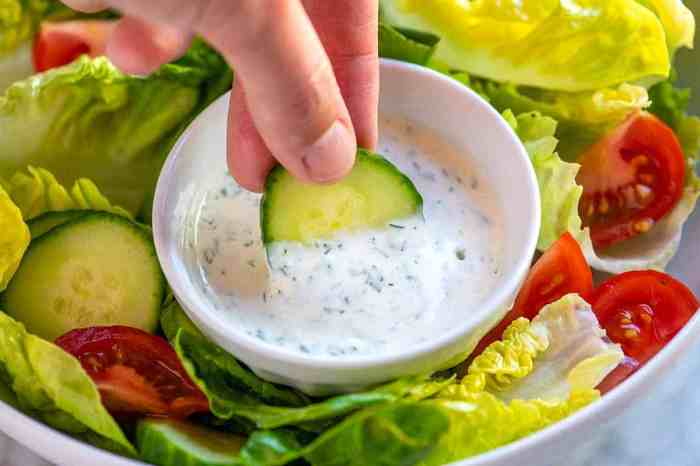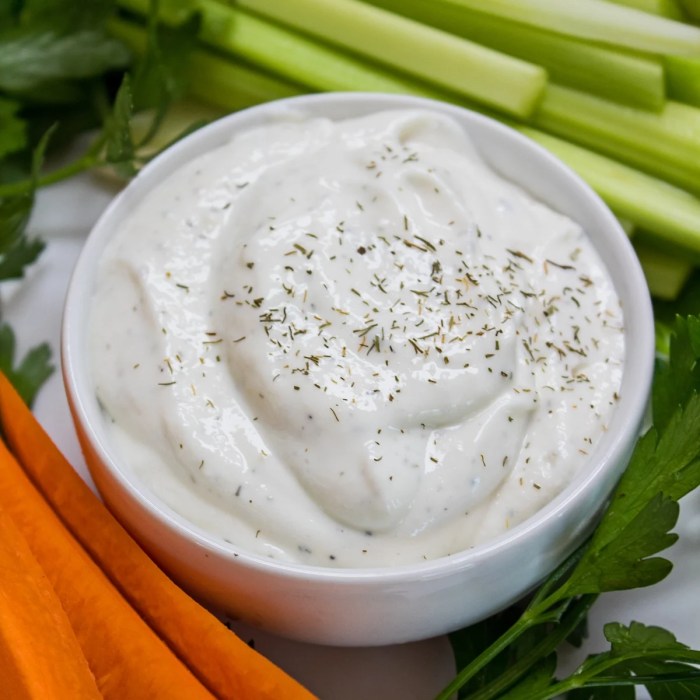Arizona Ranch Sauce Recipe A Culinary Journey
A Deep Dive into Arizona Ranch Sauce
Arizona ranch sauce recipe – Arizona Ranch dressing, while lacking a precisely documented origin story like some classic sauces, holds a unique place in the hearts (and on the plates) of many. This exploration delves into its history, variations, preparation, and culinary applications, offering a comprehensive guide for both enthusiasts and aspiring culinary creators.
History and Origin of Arizona Ranch Sauce, Arizona ranch sauce recipe

Source: inspiredtaste.net
The precise origins of Arizona Ranch dressing remain somewhat elusive, lacking the clear-cut historical narrative of some other well-known sauces. However, its development likely reflects the broader culinary landscape of the Southwestern United States, blending influences from both Mexican and American traditions. The creamy texture, herbaceous notes, and tangy undertones are indicative of this fusion. While a specific inventor or date of creation is hard to pinpoint, its rise in popularity likely correlates with the increasing demand for flavorful and versatile dressings in the latter half of the 20th century.
Arizona Ranch’s distinction lies not in a singular historical event but in its evolution as a regional favorite, adapted and refined over time through countless home cooks and restaurant kitchens.
Compared to other popular ranch dressings, Arizona Ranch often features a slightly spicier kick and a bolder herbal profile. Classic ranch dressings tend to be milder and more uniformly creamy, sometimes leaning towards a sweeter flavor. Arizona Ranch, in contrast, often incorporates ingredients like roasted chiles or jalapeños, adding a distinctive heat that sets it apart.
A simplified timeline might look like this:
- Mid-20th Century: Emergence of ranch dressing as a popular condiment in the US, influencing the development of regional variations.
- Late 20th Century: Arizona Ranch develops as a distinct variation, gaining popularity in restaurants and homes within the Southwestern region.
- 21st Century: Continued popularity and increasing online recipe sharing contributes to the sauce’s wider recognition.
Recipe Variations and Adaptations
The beauty of Arizona Ranch lies in its adaptability. Three variations, each highlighting a different balance of spice and creaminess, are presented below.
| Recipe Name | Spice Level | Creaminess | Key Ingredients |
|---|---|---|---|
| Classic Arizona Ranch | Mild | High | Buttermilk, mayonnaise, dill, chives, jalapeño (optional) |
| Spicy Southwest Ranch | Medium | Medium | Sour cream, buttermilk, cilantro, roasted poblano peppers, cumin |
| Creamy Cilantro-Lime Ranch | Low | High | Mayonnaise, sour cream, lime juice, cilantro, garlic |
Using different types of buttermilk or sour cream significantly impacts the final texture. Buttermilk, with its slightly tangy and thinner consistency, yields a lighter, less dense sauce. Sour cream, being richer and thicker, creates a creamier, more decadent dressing. Experimentation is key to finding the perfect balance.
Ingredient Sourcing and Quality

Source: bakeitwithlove.com
High-quality ingredients are paramount for creating exceptional Arizona Ranch. The freshness and quality of herbs and spices directly influence the overall flavor profile. Freshly chopped herbs offer a brighter, more vibrant taste compared to dried counterparts. Similarly, sourcing spices from reputable suppliers ensures optimal flavor and aroma.
Ideal sources for key ingredients include local farmers’ markets for fresh herbs and produce, and reputable spice vendors for high-quality spices. Seasonality should be considered; using in-season herbs and vegetables maximizes flavor and reduces environmental impact. Sustainable sourcing practices are also important.
- Suitable Substitutes: Greek yogurt can replace sour cream or buttermilk for a healthier option. Dried herbs can substitute fresh ones, although the flavor will be less intense. Cashews or other nuts can be blended to create a creamy vegan alternative to dairy products.
Preparation Methods and Techniques
Arizona Ranch can be prepared using either a blender or a whisk. A blender creates a smoother, more emulsified consistency, while a whisk requires more effort but allows for greater control over texture.
Blender Method: Combine all ingredients in a blender and blend until completely smooth. Scrape down the sides as needed to ensure thorough mixing. The resulting texture should be creamy and uniform.
Whisk Method: Whisk together the wet ingredients (buttermilk, mayonnaise, etc.) until well combined. Gradually whisk in the dry ingredients (herbs, spices, etc.), ensuring that there are no lumps. The final texture should be smooth, but may be slightly less emulsified than the blender method. Emulsification is crucial; it ensures the sauce’s creamy consistency and prevents separation. If separation occurs, a few drops of water or additional buttermilk can help restore it.
Serving Suggestions and Pairings
Arizona Ranch’s versatility extends beyond simple salads. Its bold flavors and creamy texture complement a variety of dishes.
| Dish | Flavor Combination | Textural Contrast |
|---|---|---|
| Grilled Chicken or Fish Tacos | Creamy ranch balances the spice of the tacos | Creamy sauce contrasts with the crisp taco shell |
| Baked Potatoes | Herbs and spices enhance the potato’s natural flavors | Creamy sauce complements the fluffy potato |
| Vegetable Wraps | Provides a creamy base for crunchy vegetables | Creamy sauce offsets the crisp vegetables |
| French Fries | Classic and delicious combination | Creamy sauce balances the salty fries |
| Steak | Adds a unique creamy element to the savory steak | Creamy sauce offsets the richness of the steak |
Arizona Ranch can be used as a dip for vegetables, chips, or chicken wings; as a dressing for salads and bowls; or as a marinade for meats and poultry.
The creamy tang of Arizona Ranch sauce is a favorite for many, but sometimes you crave a different kind of fruity depth. If you’re looking to explore alternative flavor profiles, you might enjoy the sweet and tart complexity found in apricot sauce recipes , which offer a surprisingly versatile complement to various dishes. Returning to the Arizona Ranch, its robust flavor stands in delightful contrast to the lighter apricot sauce.
Nutritional Information and Health Considerations
Nutritional information will vary based on the specific recipe and ingredients used. A typical serving (approximately 2 tablespoons) might contain approximately 150-200 calories, with varying amounts of fat, protein, and carbohydrates. The high fat content is a primary consideration. Using low-fat or non-fat alternatives for the dairy components can reduce the overall calorie and fat content. Reducing the amount of added salt also improves the nutritional profile.
Potential allergens include dairy, eggs (if mayonnaise is used), and certain herbs or spices depending on individual sensitivities. Always check ingredient labels carefully and adjust the recipe accordingly to accommodate dietary restrictions.
Common Queries: Arizona Ranch Sauce Recipe
Can I make Arizona Ranch Sauce ahead of time?
Yes, Arizona Ranch Sauce can be stored in an airtight container in the refrigerator for up to 5 days.
What can I substitute for buttermilk?
You can substitute plain yogurt or a mixture of milk and lemon juice for buttermilk. The flavor will be slightly different, but the texture should remain similar.
Is Arizona Ranch Sauce gluten-free?
Most Arizona Ranch Sauce recipes are naturally gluten-free, provided you use gluten-free ingredients like soy sauce (tamari) if needed.
How can I thicken the sauce if it’s too thin?
Add a tablespoon of sour cream or mayonnaise at a time until you reach the desired consistency. You can also try reducing the liquid content slightly in the initial recipe.





















